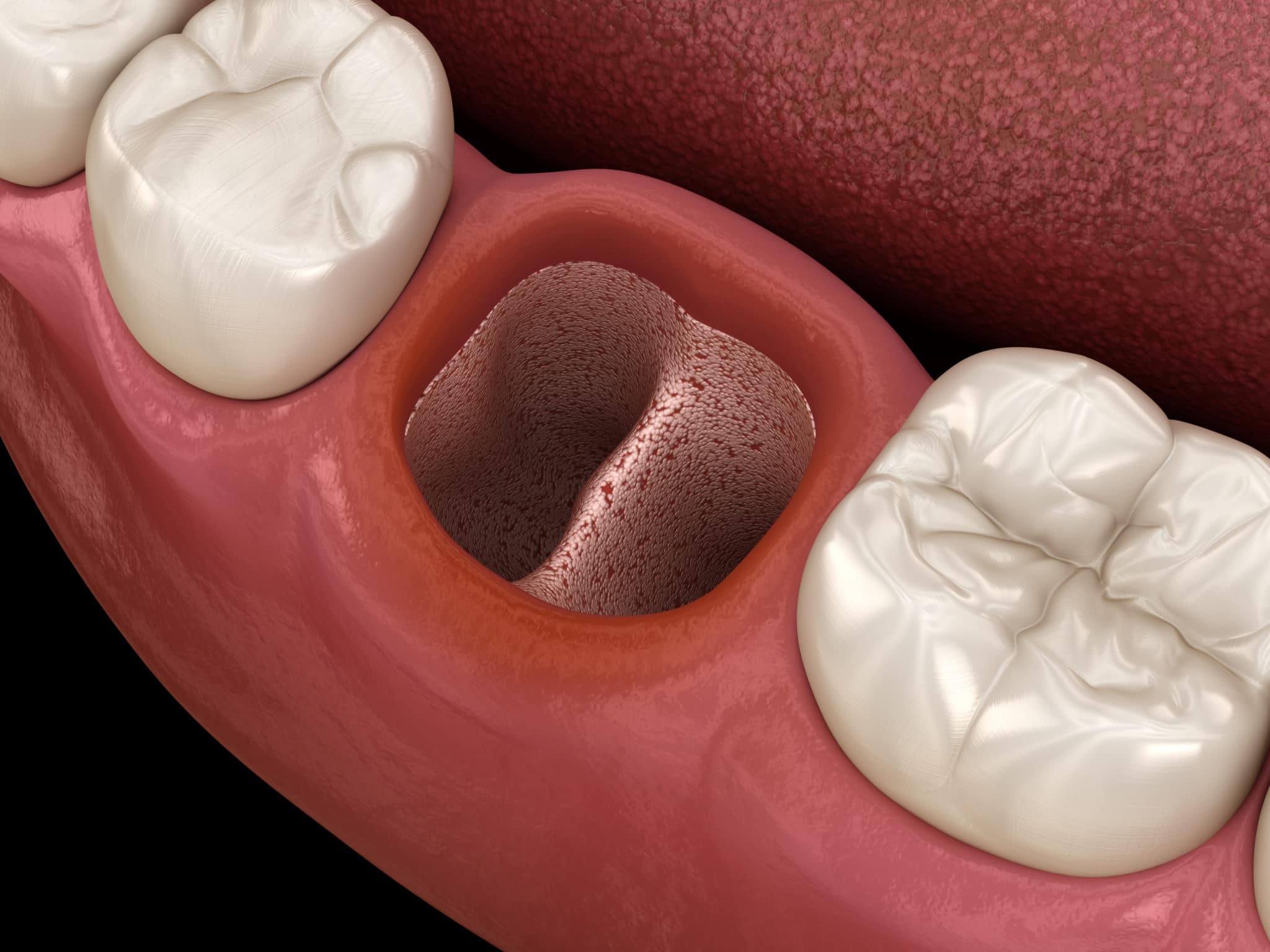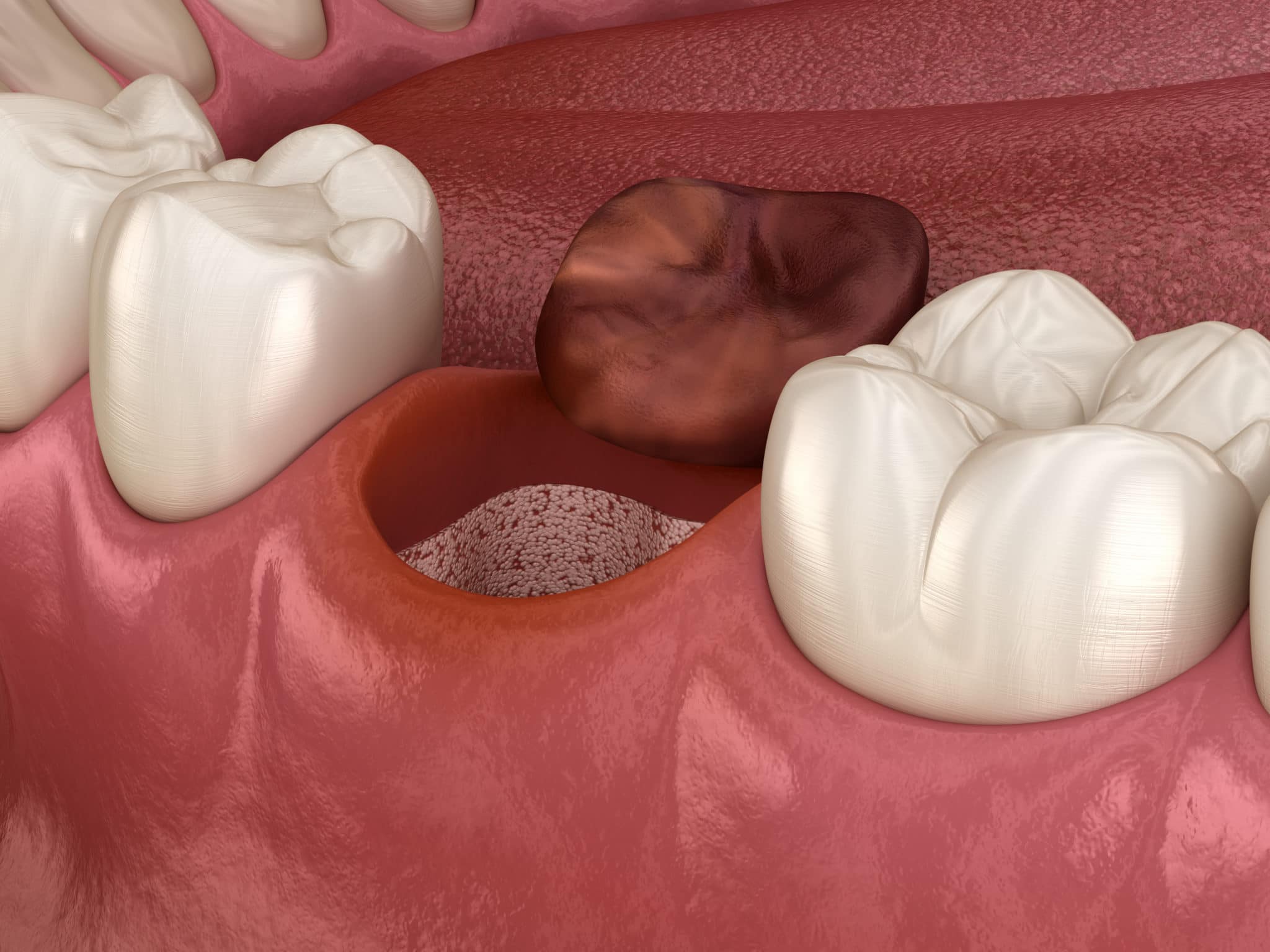The feared dry socket is one of the most common complications that occurs after an tooth extraction, particularly a wisdom tooth. If you just had a tooth extracted, and are having increased pain, you may wonder, what is dry socket. And, worse yet, do I have a dry socket?
Since I love metaphors, I want you to think of a tooth extraction like a lake. Yes, like a lake or a pond. After a tooth extraction, blood fills the site where the tooth was. Blood is what allows the body to heal. Just like a lake needs to be filled with water, a tooth extraction needs blood to heal.
What happens is that the blood washes away and the site dries out too soon. When the blood clot is lost, the site lacks the blood cells and nutrients needed for healing. A dry socket is like a lake in a drought. The lake has dried up.
The good news is a dry socket is common and there are options to easily correct it. In this article, we’ll explore the topic. We’ll talk about how to prevent a dry socket, how to treat it at home or in the office, what’s the best over-the-counter medication to take, what not to take, and I’ll even show you what a dry socket looks like. And, if you’re healing, you’re probably wondering, when can I stop worrying about dry socket? Of course, we’ll answer that too.
What is Dry Socket
A dry socket usually happens 2-3 days after a tooth extraction. It is one of the most common complications after tooth extraction. Approximately 3% of tooth extractions develop a dry socket, and as many as 30% of wisdom tooth extractions develop one.
Immediately after a tooth is removed, the body shuttles blood to the site. Over the first few hours, the blood begins clotting and covers the area of the extraction. The blood clot carries healing agents, the platelets and blood cells, and protects the bone and tissue.
In some cases the blood dilutes with saliva which washes it away, other times, the blood clot forms but can be dislodged after it develops. When the blood clot is lost within the first week of healing, a dry socket develops. It leaves the wound more exposed, which causes more sensitivity of the area, and can make it prone to infection, inflammation, and slower healing.
Dry Socket Symptoms
A dry socket happens fairly early in the process of healing, usually about two to three days after a tooth extraction. Often patients may say the area was feeling better, and then suddenly the pain worsened. If a patient had several teeth extracted, like in the case of wisdom teeth, the area with the dry socket will feel different than the others. All the sites generally will be tender, but this is different. A dry socket feels more inflamed and painful than the rest.
So what does a dry socket feel like? The area feels like an aching, throbbing pain that can radiate from the site. The lower jaw has a higher probability of developing a dry socket than the top jaw. Patients with dry socket in the lower jaw often note that the pain radiates from the tooth area along their jaw to the ear.
Let’s look at the symptoms of dry socket in a clear list:
- Throbbing, pulsing, aching pain that worsens suddenly
- Radiating pain
- Inflammation or swelling in the area
- Feeling of heat in the area of the extraction
- Bad breath
- Unpleasant taste in mouth
What does Dry Socket Look Like
A dry socket looks inflamed and irritated. The site may be difficult to determine by an untrained eye. The key details is that the gums are delayed in closing over the extraction site compared to a normally healing tooth extraction. Let’s look at some images of how dry sockets appear to give you a sense of how it looks.
Oh and in case you’re wondering how long the hole takes to close after a tooth extraction, check out this article.

How to Prevent Dry Socket and What Causes Dry Sockets?
Mechanical: The most common causes of dry socket are from sucking through a straw or cigarette, as well as vigorously rinsing your mouth. All these actions create a force on the blood clot that is sitting in the healing site, and can accidentally cause it to dislodge or wash away.
Smoking: Smoking not only provides a mechanical interference to healing, but also nicotine impairs healing and decreases new blood vessel formation, thus increasing the likelihood of a dry socket.
Infection: Healing after removing a tooth that was infected has a higher probability of developing a dry socket. The bacteria and pus in the area, can create a secondary infection during healing, and interfere with the process of developing a clot. Many dentists and oral surgeons prescribe antibiotics after a tooth extraction to prevent infection while the tooth extraction heals.
Biologic: There are medical factors that increase the likelihood of a dry socket. One factor is the history of systemic diseases like uncontrolled diabetes and some autoimmune diseases. Furthermore, medications such as oral contraceptives have shown to have a small increase in risk for dry sockets.
For more tips of the do’s and don’ts for the best healing after tooth extraction check out this article.
Dry Socket Treatment
In Office Treatment:
So here’s the deal. If it’s been two or three days after your tooth extraction, its relatively normal to have moderate pain, swelling, and tenderness. Do not be too alarmed, but if you feel the pain is worsening, you may have developed a dry socket. Call your treating dentist or oral surgeon. Dry sockets are easily diagnosed and treated.
Your dentist may request for you to come in for a followup. If they determine you have developed a dry socket, the treatment is routine and simple. Tycally, the dentist will numb the area, and clean it out. The key to the process is to remove any irritants and allow blood to refill the area, effectively jump-starting the healing again.
Some dentists place a medicated strip of gauze into the site, but not all do. The key is simply to allow the blood clot to form again, with or without a medicated guaze, the site will begin healing again.
Now, its important to realize, the extraction site won’t feel better immediately. It will still be sore, but should begin to feel better in 1-3 days. Hang in there, you’re on the right track. Sometimes a dry socket also becomes infected, if food or bacteria get caught in the site. In these cases, the dentist or oral surgeon may prescribe an additional antibiotic or a medicated mouthrinse, typically chlorohexidine.
Home Remedies:
If you are unable to come into the office immediately, be sure to keep food away from the area to prevent it from getting caught, further irritating the dry socket. You can use warm compresses to help soothe the pain. Dipping a clean facecloth into a bowl of water that was microwaved for 20-30 seconds usually does the trick.
For pain, you will typically want to rely on the medication your dentist prescribed or an over the counter medication like ibuprofen every 6-8 hours. A great alternative to ibuprofen is naproxen which generally lasts significantly longer than ibuprofen. And if you happen to be unable to take NSAIDs due to stomach issues or other reasons, acetaminophen is the next best alternative.
Some patients also find that a few drops of clove oil can help when it is placed into the extraction site. Clove oil can often be found at pharmacies, health food stores, and even grocery stores. The clove oil helps to temporarily relieve pain of a dry socket. You may repeat a few times a day until you can get to the office for followup. Your treating dentist should still evaluate the site even if your treating it at home.
What not to take
When you’re in pain, you can be convinced to try anything to relieve the pain. But as someone who’s seen it a million times, I can help steer you away from the medications that will waste your time.
When you have a dry socket, most people think that numbing the gums is their first choice. So they look for gel analgesics like oragel or dentek eugenol to try to numb the gums. These products work great on things like mouth ulcers, burns, etc. But they generally are not as helpful for dry sockets.
The reason is that the pain from a dry socket is deeply internal to the area. It’s difficult to numb the area where the pain is by rubbing gel around the area and it can lead to the pain worsening by continually disturbing the area as it’s healing.
When Can I Stop Worrying About Dry Socket

If you think you have a dry socket, the first thing you’re wondering is, how long does a dry socket last, right? I know, I should have put this answer first, but for context it fits in better here. Luckily the answer to when you can stop worrying about a dry socket is simple.
Most dry sockets last 7-10 days. A small percentage will last longer than a week.
You are usually in the clear and probably won’t develop a dry socket when you are past the first week of tooth removal.
How to Prevent a Dry Socket
When you have a tooth extracted, the first 3-4 days are the most critical for preventing a dry socket. As with most things, its easier to prevent a problem than to treat it. The same principle applies here.
First things first, be sure to following the specific instructions recommended by your dentist or oral surgeon. That includes taking the medications prescribed as directed. If you dentist prescribes an oral antibiotic, be sure to take the entire course. Avoid using any mouthrinses unless you discussed it with your dentist.
Following the instructions for your particular circumstance is the best method of how to prevent a dry socket. In case you’re thirsty for even more peace of mind, here’s my top tips of how to prevent a dry socket.
Top tips for prevention:
- No rinsing for 24 hours (then only VERY gentle rinsing after 24 hours; Avoid mouthrinses containing alcohol for 2 weeks)
- No drinking from straws for 10 days
- No smoking for 72 hours (but ideally 1 week)
- Avoid spicy foods
- Avoiding crunchy foods (chips, nuts, popcorn, etc.) For creative tips read: What to eat after tooth extraction
- Avoid alcohol for 1 week
- Limiting physical activity for 5-7 days such as strenuous exercise or difficult physical labor at work
Who is Higher Risk?
As we discussed, a dry socket is one of the most common complications after a tooth extraction. There are a few situations when the complication is more likely to develop. You are at a higher risk for dry socket if you:
- Had a wisdom tooth extracted
- Have a history of dry socket
- Had a tooth in the lower jaw removed
- Have an autoimmune disease like lupus, rheutoid arthritis, etc
- Had an extraction of a large erupted tooth like a first, second, or third molar
- Take birth control
- Are a smoker
- Had an tooth extraction of a tooth that was infected
- Have a history of poor dental hygiene
- Take medication that inhibits blood clotting
Putting it all together
If you had a tooth extracted and are healing, hang in there. With or without a dry socket, the healing is intense for a few days, but subsides rather quickly. To give you a sense, the gums of the mouth heal about 2.5x as fast as the human skin. If you can compare the healing of a bump or bruise on your skin to a tooth extraction, you will find the mouth heals much faster. Hopefully that little gem of knowledge provides some comfort.
To wrap up a delightfully dry article about conincidentally, dry sockets, I’ll leave you with this final thought.
Did you know that the tooth fairy has been around for decades now? The average amount of money left by the tooth fairy in 1950 was 25 cents. In 1985 it was $1.00, the going rate now is $5.00. Some tooth fairies are especially generous, pending history of good behavior.


